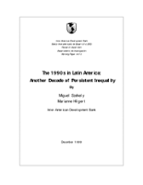The 1990s in Latin America: Another Decade of Persistent Inequality
Date
Dec 1999
This paper argues that there is no country in Latin America where we can confidently say that income inequality improved during the 1990s. We document this fact for the 15 countries where comparable household surveys, covering most of the population, are available. What we observe are genuine distributive changes, which are being driven neither by differences in the characteristics of the data nor by the way in which the data is treated. In 10 of the countries, the lack of progress is driven by increases in inequality among the first nine deciles. In the remaining 5, the reason is a greater concentration among the richest 10% of the population. We also observe that in 7 countries, the dynamics among individuals with 14 years or more of schooling are the main reason why income distribution has not improved in the 1990s. However, the lack of progress in income distribution is not exclusive to this region. We compare Latin America internationally and find that, with few exceptions, inequality has increased less in this region than in developed countries and in Eastern Europe.



